Tax Analysis and Corporate Accounting Report - Eureka Group Holdings
VerifiedAdded on 2020/05/16
|12
|2265
|54
Report
AI Summary
This report presents a tax analysis and corporate accounting review of Eureka Group Holdings Limited. The analysis delves into the company's equity structure, highlighting the common stock and retained earnings. It examines the company's tax obligations, revealing that Eureka Group Holdings Limited is exempt from paying taxes. The report explores the differences between accounting and tax rules, explaining why the income tax expense shown in the income statement differs from the tax rate times the computed amount. It discusses deferred tax assets and liabilities, noting that the company has no deferred tax liabilities. Furthermore, the report compares current tax expenses and payable amounts, as well as the discrepancies between income tax expenses in the income statement and income tax paid in the cash flow statement. The report concludes by reflecting on the interesting, surprising, and difficult aspects of the company's tax recording practices, offering new insights into the governance structure and the impact of tax exemptions.
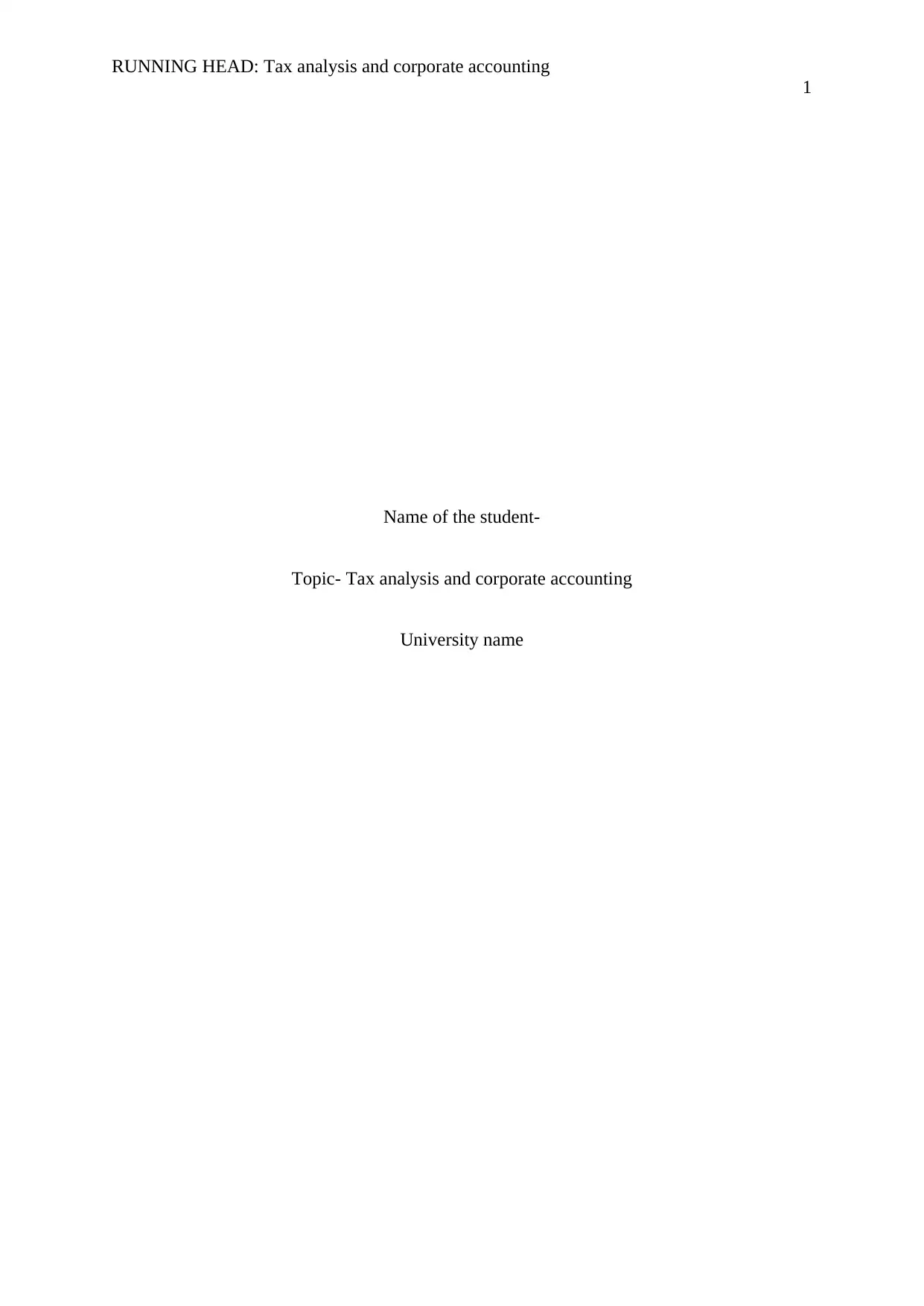
RUNNING HEAD: Tax analysis and corporate accounting
1
Name of the student-
Topic- Tax analysis and corporate accounting
University name
1
Name of the student-
Topic- Tax analysis and corporate accounting
University name
Paraphrase This Document
Need a fresh take? Get an instant paraphrase of this document with our AI Paraphraser

Tax analysis and corporate accounting
2
Table of Contents
Answer to question-1.............................................................................................................................3
Answer to question-2.............................................................................................................................5
Answer to question no-3........................................................................................................................5
Answer to question no-4........................................................................................................................7
Answer to question no-5........................................................................................................................8
Answer to question no-6........................................................................................................................9
Answer to question no-7........................................................................................................................9
References...........................................................................................................................................12
.
2
Table of Contents
Answer to question-1.............................................................................................................................3
Answer to question-2.............................................................................................................................5
Answer to question no-3........................................................................................................................5
Answer to question no-4........................................................................................................................7
Answer to question no-5........................................................................................................................8
Answer to question no-6........................................................................................................................9
Answer to question no-7........................................................................................................................9
References...........................................................................................................................................12
.
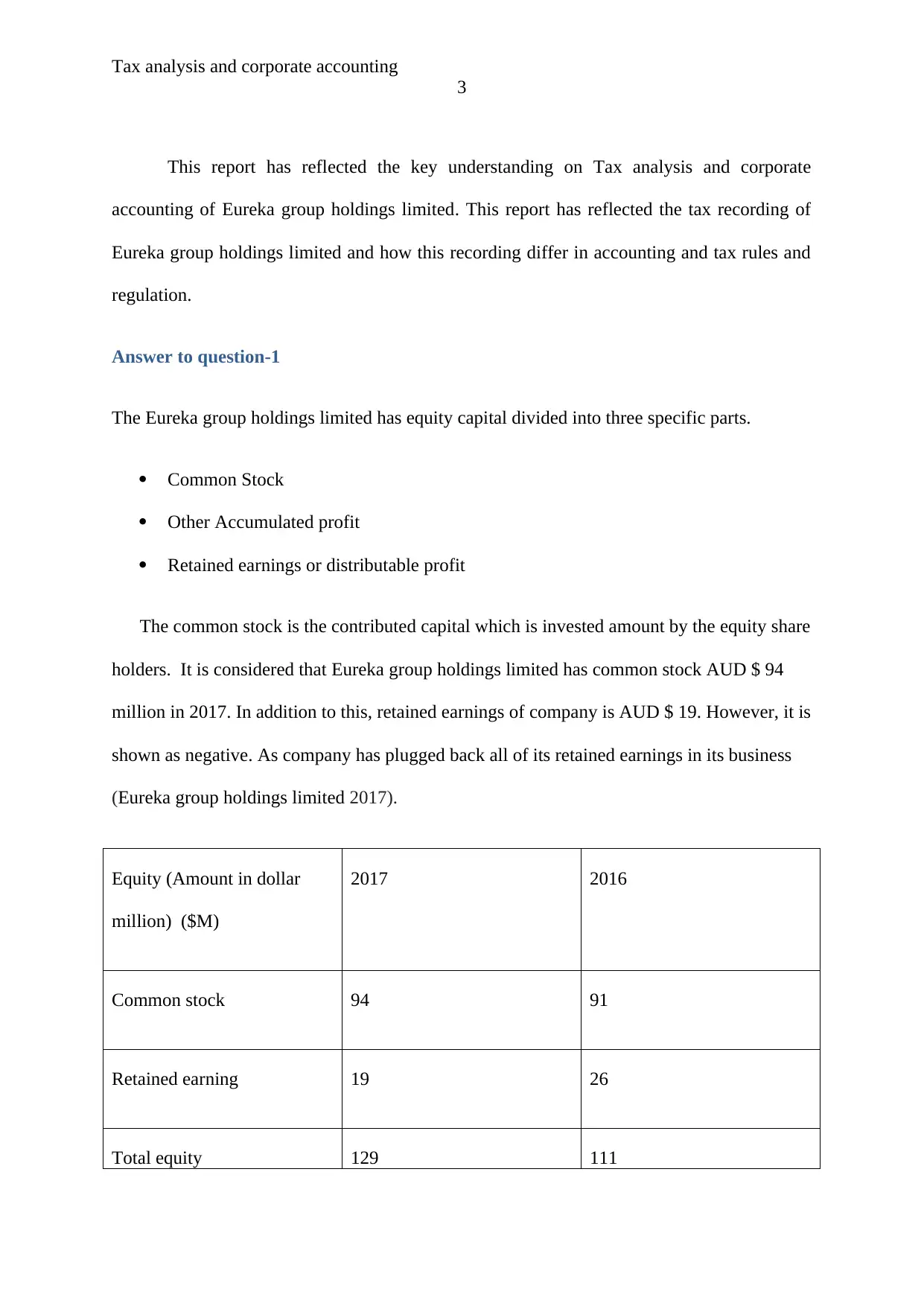
Tax analysis and corporate accounting
3
This report has reflected the key understanding on Tax analysis and corporate
accounting of Eureka group holdings limited. This report has reflected the tax recording of
Eureka group holdings limited and how this recording differ in accounting and tax rules and
regulation.
Answer to question-1
The Eureka group holdings limited has equity capital divided into three specific parts.
Common Stock
Other Accumulated profit
Retained earnings or distributable profit
The common stock is the contributed capital which is invested amount by the equity share
holders. It is considered that Eureka group holdings limited has common stock AUD $ 94
million in 2017. In addition to this, retained earnings of company is AUD $ 19. However, it is
shown as negative. As company has plugged back all of its retained earnings in its business
(Eureka group holdings limited 2017).
Equity (Amount in dollar
million) ($M)
2017 2016
Common stock 94 91
Retained earning 19 26
Total equity 129 111
3
This report has reflected the key understanding on Tax analysis and corporate
accounting of Eureka group holdings limited. This report has reflected the tax recording of
Eureka group holdings limited and how this recording differ in accounting and tax rules and
regulation.
Answer to question-1
The Eureka group holdings limited has equity capital divided into three specific parts.
Common Stock
Other Accumulated profit
Retained earnings or distributable profit
The common stock is the contributed capital which is invested amount by the equity share
holders. It is considered that Eureka group holdings limited has common stock AUD $ 94
million in 2017. In addition to this, retained earnings of company is AUD $ 19. However, it is
shown as negative. As company has plugged back all of its retained earnings in its business
(Eureka group holdings limited 2017).
Equity (Amount in dollar
million) ($M)
2017 2016
Common stock 94 91
Retained earning 19 26
Total equity 129 111
⊘ This is a preview!⊘
Do you want full access?
Subscribe today to unlock all pages.

Trusted by 1+ million students worldwide
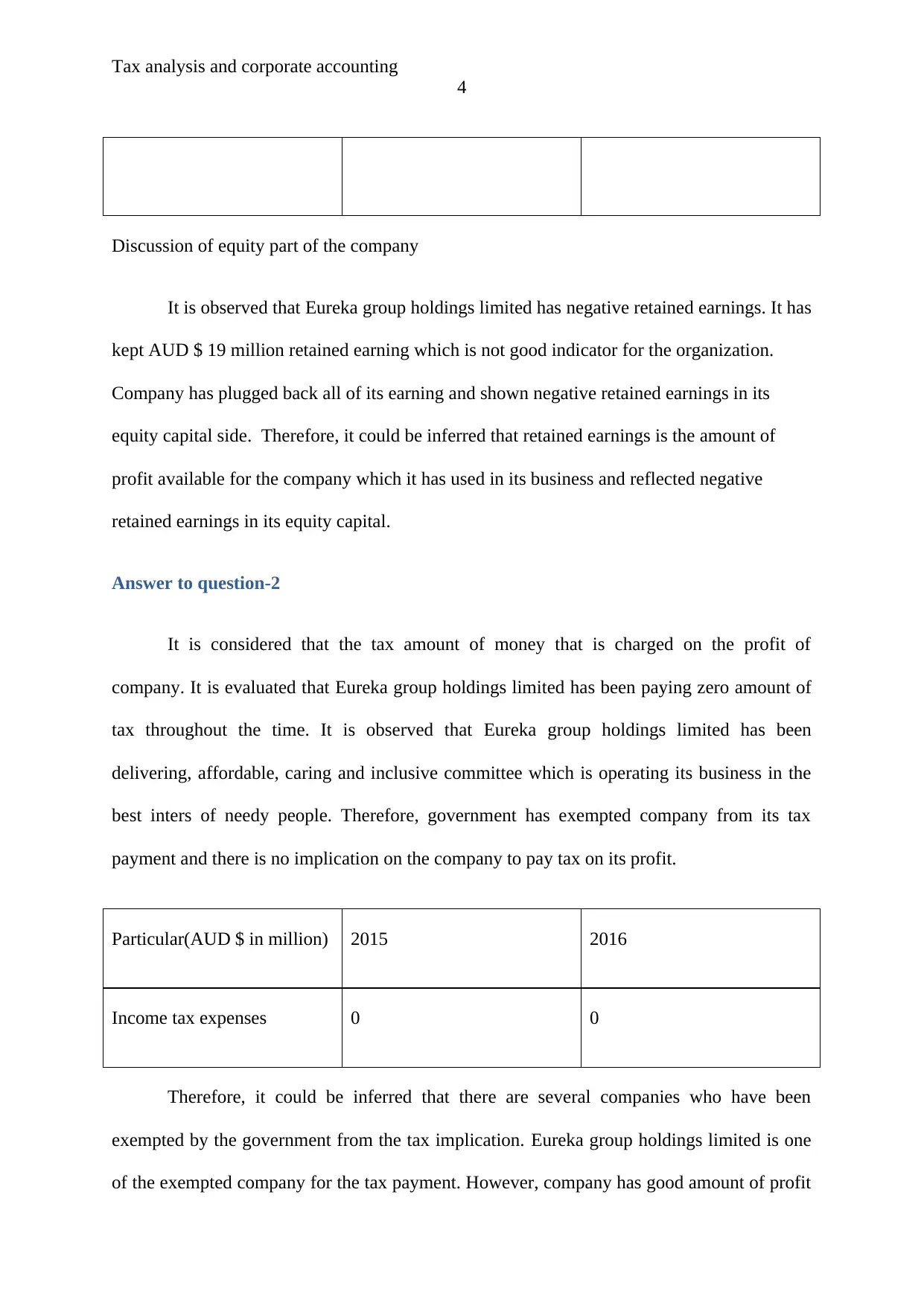
Tax analysis and corporate accounting
4
Discussion of equity part of the company
It is observed that Eureka group holdings limited has negative retained earnings. It has
kept AUD $ 19 million retained earning which is not good indicator for the organization.
Company has plugged back all of its earning and shown negative retained earnings in its
equity capital side. Therefore, it could be inferred that retained earnings is the amount of
profit available for the company which it has used in its business and reflected negative
retained earnings in its equity capital.
Answer to question-2
It is considered that the tax amount of money that is charged on the profit of
company. It is evaluated that Eureka group holdings limited has been paying zero amount of
tax throughout the time. It is observed that Eureka group holdings limited has been
delivering, affordable, caring and inclusive committee which is operating its business in the
best inters of needy people. Therefore, government has exempted company from its tax
payment and there is no implication on the company to pay tax on its profit.
Particular(AUD $ in million) 2015 2016
Income tax expenses 0 0
Therefore, it could be inferred that there are several companies who have been
exempted by the government from the tax implication. Eureka group holdings limited is one
of the exempted company for the tax payment. However, company has good amount of profit
4
Discussion of equity part of the company
It is observed that Eureka group holdings limited has negative retained earnings. It has
kept AUD $ 19 million retained earning which is not good indicator for the organization.
Company has plugged back all of its earning and shown negative retained earnings in its
equity capital side. Therefore, it could be inferred that retained earnings is the amount of
profit available for the company which it has used in its business and reflected negative
retained earnings in its equity capital.
Answer to question-2
It is considered that the tax amount of money that is charged on the profit of
company. It is evaluated that Eureka group holdings limited has been paying zero amount of
tax throughout the time. It is observed that Eureka group holdings limited has been
delivering, affordable, caring and inclusive committee which is operating its business in the
best inters of needy people. Therefore, government has exempted company from its tax
payment and there is no implication on the company to pay tax on its profit.
Particular(AUD $ in million) 2015 2016
Income tax expenses 0 0
Therefore, it could be inferred that there are several companies who have been
exempted by the government from the tax implication. Eureka group holdings limited is one
of the exempted company for the tax payment. However, company has good amount of profit
Paraphrase This Document
Need a fresh take? Get an instant paraphrase of this document with our AI Paraphraser

Tax analysis and corporate accounting
5
in its business which is plugged back by company in its business operations for the
betterment of society and people at large. It has reduced the income tax burden of company in
determined approach.
Answer to question no-3
It is observed that tax expenses of Eureka group holdings limited has been shown in
the income statement as zero. Company is having zero level of tax implication due to the
exemption granted to it. The Eureka group a holding limited is wholly owned Australian
resident entity that have formed tax-consolidation group with effect from 1st July 2003. On
the other hand, company has not paid any tax in any of its financial year. However, in order
to answer the fact whether the income tax charged is equal to the tax rate times computed on
the net profit following information could be drawn. The tax rate 30% is the standard tax rate
which is determined with a view to determine the tax rate of income in determined approach.
The tax charged on the profit of company which is implicated as per the rules and
regulations of income tax.
In addition to this, tax rate times is computed by using accounting income* 30% tax
rate, i.e. 6538*30%. This amount is AUD $ 1961.4 million. Therefore, due to the difference
in accounting rules and income tax rules, tax amount shown in the income statement would
be differ from the tax rate times computed.
Explain why this
The main reason for this is based on the difference in accounting rules and income tax
rules applicable on the company.
5
in its business which is plugged back by company in its business operations for the
betterment of society and people at large. It has reduced the income tax burden of company in
determined approach.
Answer to question no-3
It is observed that tax expenses of Eureka group holdings limited has been shown in
the income statement as zero. Company is having zero level of tax implication due to the
exemption granted to it. The Eureka group a holding limited is wholly owned Australian
resident entity that have formed tax-consolidation group with effect from 1st July 2003. On
the other hand, company has not paid any tax in any of its financial year. However, in order
to answer the fact whether the income tax charged is equal to the tax rate times computed on
the net profit following information could be drawn. The tax rate 30% is the standard tax rate
which is determined with a view to determine the tax rate of income in determined approach.
The tax charged on the profit of company which is implicated as per the rules and
regulations of income tax.
In addition to this, tax rate times is computed by using accounting income* 30% tax
rate, i.e. 6538*30%. This amount is AUD $ 1961.4 million. Therefore, due to the difference
in accounting rules and income tax rules, tax amount shown in the income statement would
be differ from the tax rate times computed.
Explain why this
The main reason for this is based on the difference in accounting rules and income tax
rules applicable on the company.
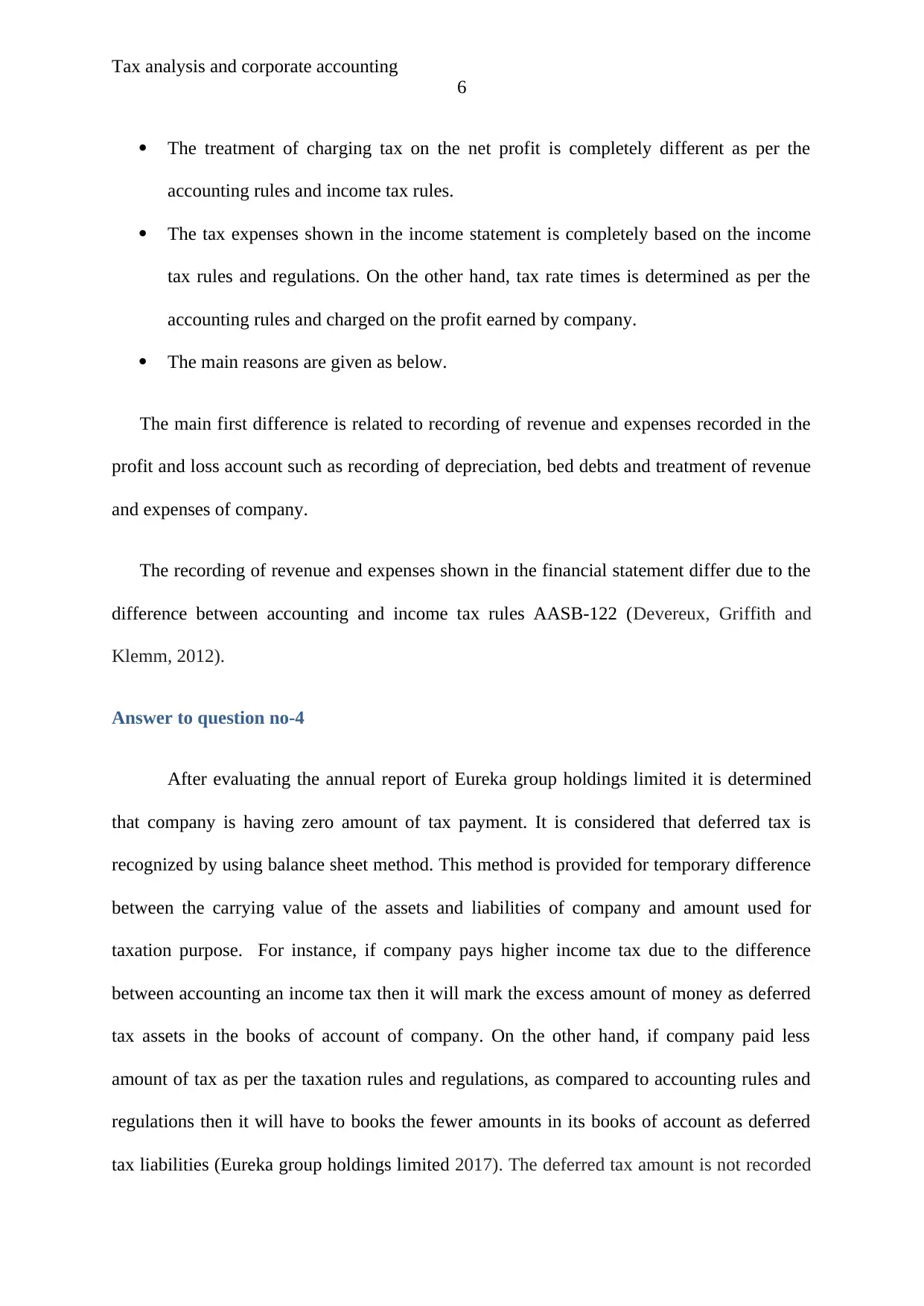
Tax analysis and corporate accounting
6
The treatment of charging tax on the net profit is completely different as per the
accounting rules and income tax rules.
The tax expenses shown in the income statement is completely based on the income
tax rules and regulations. On the other hand, tax rate times is determined as per the
accounting rules and charged on the profit earned by company.
The main reasons are given as below.
The main first difference is related to recording of revenue and expenses recorded in the
profit and loss account such as recording of depreciation, bed debts and treatment of revenue
and expenses of company.
The recording of revenue and expenses shown in the financial statement differ due to the
difference between accounting and income tax rules AASB-122 (Devereux, Griffith and
Klemm, 2012).
Answer to question no-4
After evaluating the annual report of Eureka group holdings limited it is determined
that company is having zero amount of tax payment. It is considered that deferred tax is
recognized by using balance sheet method. This method is provided for temporary difference
between the carrying value of the assets and liabilities of company and amount used for
taxation purpose. For instance, if company pays higher income tax due to the difference
between accounting an income tax then it will mark the excess amount of money as deferred
tax assets in the books of account of company. On the other hand, if company paid less
amount of tax as per the taxation rules and regulations, as compared to accounting rules and
regulations then it will have to books the fewer amounts in its books of account as deferred
tax liabilities (Eureka group holdings limited 2017). The deferred tax amount is not recorded
6
The treatment of charging tax on the net profit is completely different as per the
accounting rules and income tax rules.
The tax expenses shown in the income statement is completely based on the income
tax rules and regulations. On the other hand, tax rate times is determined as per the
accounting rules and charged on the profit earned by company.
The main reasons are given as below.
The main first difference is related to recording of revenue and expenses recorded in the
profit and loss account such as recording of depreciation, bed debts and treatment of revenue
and expenses of company.
The recording of revenue and expenses shown in the financial statement differ due to the
difference between accounting and income tax rules AASB-122 (Devereux, Griffith and
Klemm, 2012).
Answer to question no-4
After evaluating the annual report of Eureka group holdings limited it is determined
that company is having zero amount of tax payment. It is considered that deferred tax is
recognized by using balance sheet method. This method is provided for temporary difference
between the carrying value of the assets and liabilities of company and amount used for
taxation purpose. For instance, if company pays higher income tax due to the difference
between accounting an income tax then it will mark the excess amount of money as deferred
tax assets in the books of account of company. On the other hand, if company paid less
amount of tax as per the taxation rules and regulations, as compared to accounting rules and
regulations then it will have to books the fewer amounts in its books of account as deferred
tax liabilities (Eureka group holdings limited 2017). The deferred tax amount is not recorded
⊘ This is a preview!⊘
Do you want full access?
Subscribe today to unlock all pages.

Trusted by 1+ million students worldwide
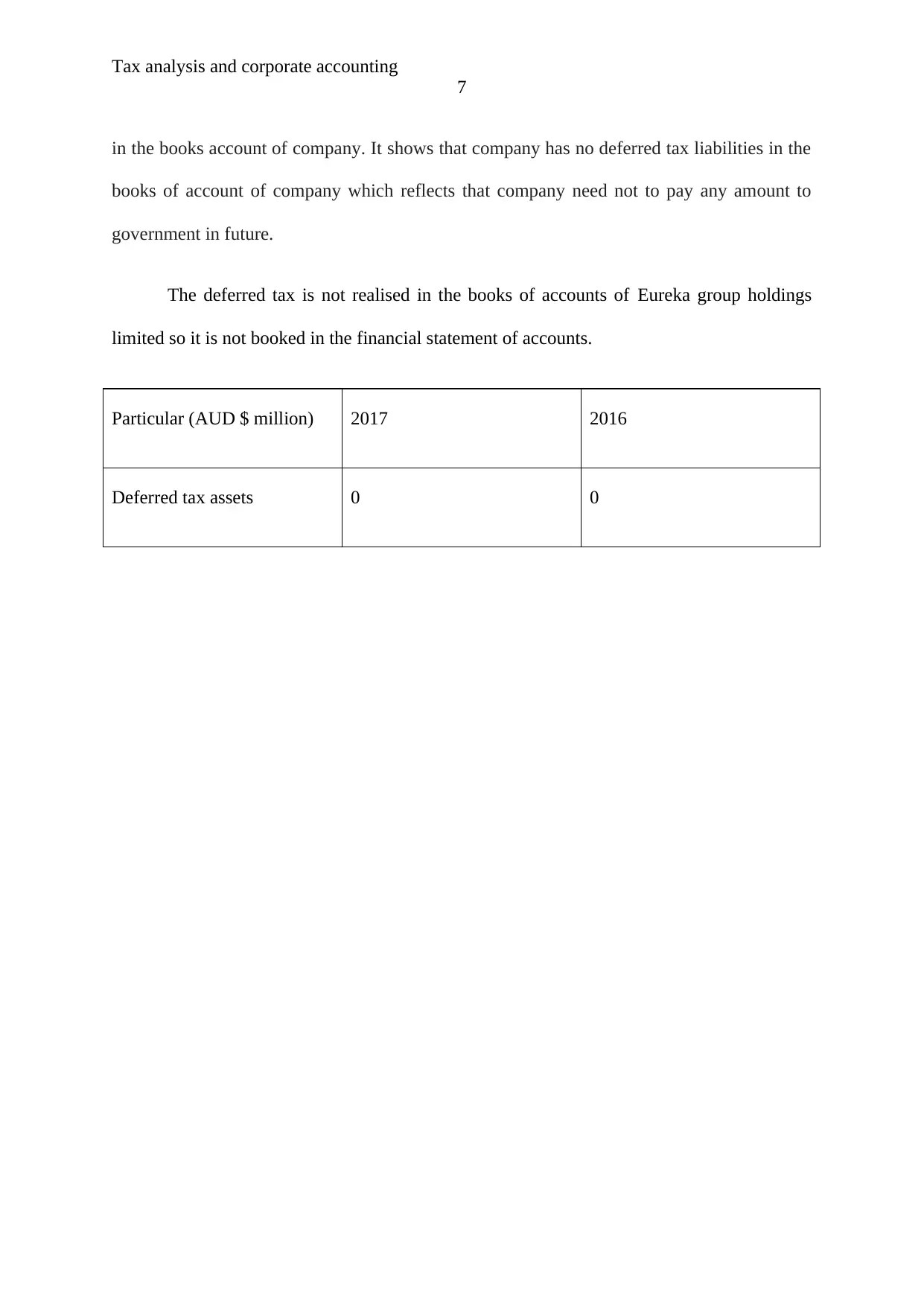
Tax analysis and corporate accounting
7
in the books account of company. It shows that company has no deferred tax liabilities in the
books of account of company which reflects that company need not to pay any amount to
government in future.
The deferred tax is not realised in the books of accounts of Eureka group holdings
limited so it is not booked in the financial statement of accounts.
Particular (AUD $ million) 2017 2016
Deferred tax assets 0 0
7
in the books account of company. It shows that company has no deferred tax liabilities in the
books of account of company which reflects that company need not to pay any amount to
government in future.
The deferred tax is not realised in the books of accounts of Eureka group holdings
limited so it is not booked in the financial statement of accounts.
Particular (AUD $ million) 2017 2016
Deferred tax assets 0 0
Paraphrase This Document
Need a fresh take? Get an instant paraphrase of this document with our AI Paraphraser

Tax analysis and corporate accounting
8
Answer to question no-5
Current tax payable and current tax expenses of Eureka group holdings limited
It is evaluated that current tax is charged on the profit of Eureka group holdings
limited. However, due to the tax exemption, company has paid zero amount of tax to
government. Therefore, there is no amount of tax payable by company to government. The
current tax is charged as per the taxation rules and regulations given under AASB 112. The
current tax reflects the amount of tax charged on the profit of company in current year. On
the other hand, current tax payable is the amount of overall tax payable by company to
government. The current tax payment is shown in income statement and tax payable amount
is recorded in the liabilities side of financial statement of company (Garrett, Hoitash and
Prawitt, 2014). Therefore, it could be inferred that company has not current tax expenses nor
any tax payable. It has showcased no liabilities on company.
Deferred tax payment of Eureka group holdings limited is also zero.
Particular(AUD $ in million) 2016 2017
Income tax Expenses 0 0
Why income tax expenses is not same as the income tax payable
There are several reasons which have resulted to differences between tax expenses
and tax payable company.
8
Answer to question no-5
Current tax payable and current tax expenses of Eureka group holdings limited
It is evaluated that current tax is charged on the profit of Eureka group holdings
limited. However, due to the tax exemption, company has paid zero amount of tax to
government. Therefore, there is no amount of tax payable by company to government. The
current tax is charged as per the taxation rules and regulations given under AASB 112. The
current tax reflects the amount of tax charged on the profit of company in current year. On
the other hand, current tax payable is the amount of overall tax payable by company to
government. The current tax payment is shown in income statement and tax payable amount
is recorded in the liabilities side of financial statement of company (Garrett, Hoitash and
Prawitt, 2014). Therefore, it could be inferred that company has not current tax expenses nor
any tax payable. It has showcased no liabilities on company.
Deferred tax payment of Eureka group holdings limited is also zero.
Particular(AUD $ in million) 2016 2017
Income tax Expenses 0 0
Why income tax expenses is not same as the income tax payable
There are several reasons which have resulted to differences between tax expenses
and tax payable company.
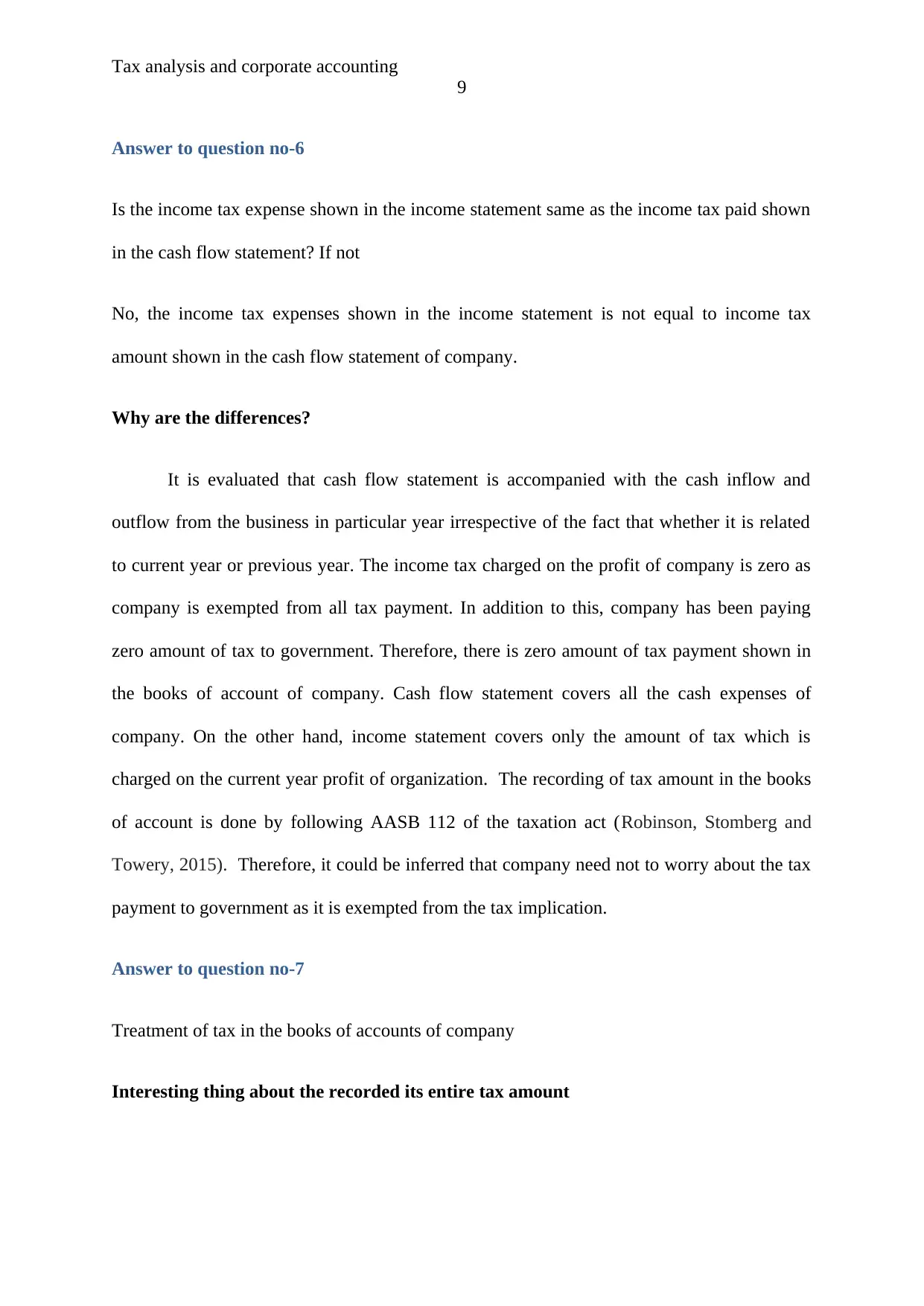
Tax analysis and corporate accounting
9
Answer to question no-6
Is the income tax expense shown in the income statement same as the income tax paid shown
in the cash flow statement? If not
No, the income tax expenses shown in the income statement is not equal to income tax
amount shown in the cash flow statement of company.
Why are the differences?
It is evaluated that cash flow statement is accompanied with the cash inflow and
outflow from the business in particular year irrespective of the fact that whether it is related
to current year or previous year. The income tax charged on the profit of company is zero as
company is exempted from all tax payment. In addition to this, company has been paying
zero amount of tax to government. Therefore, there is zero amount of tax payment shown in
the books of account of company. Cash flow statement covers all the cash expenses of
company. On the other hand, income statement covers only the amount of tax which is
charged on the current year profit of organization. The recording of tax amount in the books
of account is done by following AASB 112 of the taxation act (Robinson, Stomberg and
Towery, 2015). Therefore, it could be inferred that company need not to worry about the tax
payment to government as it is exempted from the tax implication.
Answer to question no-7
Treatment of tax in the books of accounts of company
Interesting thing about the recorded its entire tax amount
9
Answer to question no-6
Is the income tax expense shown in the income statement same as the income tax paid shown
in the cash flow statement? If not
No, the income tax expenses shown in the income statement is not equal to income tax
amount shown in the cash flow statement of company.
Why are the differences?
It is evaluated that cash flow statement is accompanied with the cash inflow and
outflow from the business in particular year irrespective of the fact that whether it is related
to current year or previous year. The income tax charged on the profit of company is zero as
company is exempted from all tax payment. In addition to this, company has been paying
zero amount of tax to government. Therefore, there is zero amount of tax payment shown in
the books of account of company. Cash flow statement covers all the cash expenses of
company. On the other hand, income statement covers only the amount of tax which is
charged on the current year profit of organization. The recording of tax amount in the books
of account is done by following AASB 112 of the taxation act (Robinson, Stomberg and
Towery, 2015). Therefore, it could be inferred that company need not to worry about the tax
payment to government as it is exempted from the tax implication.
Answer to question no-7
Treatment of tax in the books of accounts of company
Interesting thing about the recorded its entire tax amount
⊘ This is a preview!⊘
Do you want full access?
Subscribe today to unlock all pages.

Trusted by 1+ million students worldwide

Tax analysis and corporate accounting
10
The main interesting thing about the recording of entire tax amount is based on the
recording of tax as per the accounting rules and regulations. It may results to differences
between accounting profit and profit computed by income tax rules and regulations. This
difference in amount may be recorded as deferred tax assets or deferred tax liabilities in the
financial statement of company. This is really interesting thing about the company which has
shown that company has positive recording of assets in the books of accounts
Surprising thing about the recorded its entire tax amount
The main surprising thing about the recording of entries tax amount in Eureka group
holdings limited is related to its corporate governance. Government of Australia has
exempted various companies and bodies from the tax burden. Eureka group holdings limited
is one of the selected company which is not allowed to pay tax to government. (Eureka group
holdings limited, 2017).
Difficulty in recorded the entire tax amount
Eureka group holdings limited has been exempted from the tax burden by the
government. It is evaluated that company has not paid any tax in its books of account as per
the AASB-112 income tax rules and regulations. It has increased the complexity in recording
of income tax. As per the accounting rules and regulations, company should pay tax amount
of AUD $ 1491million to government then it will increase the overall outcomes of the
organization (Eureka group holdings limited, 2017).
New insight about the company account for the income tax
The main insight about the income tax recording is related to governance structure of
company. It is evaluated that Eureka group holdings limited is falling under the exemption
10
The main interesting thing about the recording of entire tax amount is based on the
recording of tax as per the accounting rules and regulations. It may results to differences
between accounting profit and profit computed by income tax rules and regulations. This
difference in amount may be recorded as deferred tax assets or deferred tax liabilities in the
financial statement of company. This is really interesting thing about the company which has
shown that company has positive recording of assets in the books of accounts
Surprising thing about the recorded its entire tax amount
The main surprising thing about the recording of entries tax amount in Eureka group
holdings limited is related to its corporate governance. Government of Australia has
exempted various companies and bodies from the tax burden. Eureka group holdings limited
is one of the selected company which is not allowed to pay tax to government. (Eureka group
holdings limited, 2017).
Difficulty in recorded the entire tax amount
Eureka group holdings limited has been exempted from the tax burden by the
government. It is evaluated that company has not paid any tax in its books of account as per
the AASB-112 income tax rules and regulations. It has increased the complexity in recording
of income tax. As per the accounting rules and regulations, company should pay tax amount
of AUD $ 1491million to government then it will increase the overall outcomes of the
organization (Eureka group holdings limited, 2017).
New insight about the company account for the income tax
The main insight about the income tax recording is related to governance structure of
company. It is evaluated that Eureka group holdings limited is falling under the exemption
Paraphrase This Document
Need a fresh take? Get an instant paraphrase of this document with our AI Paraphraser
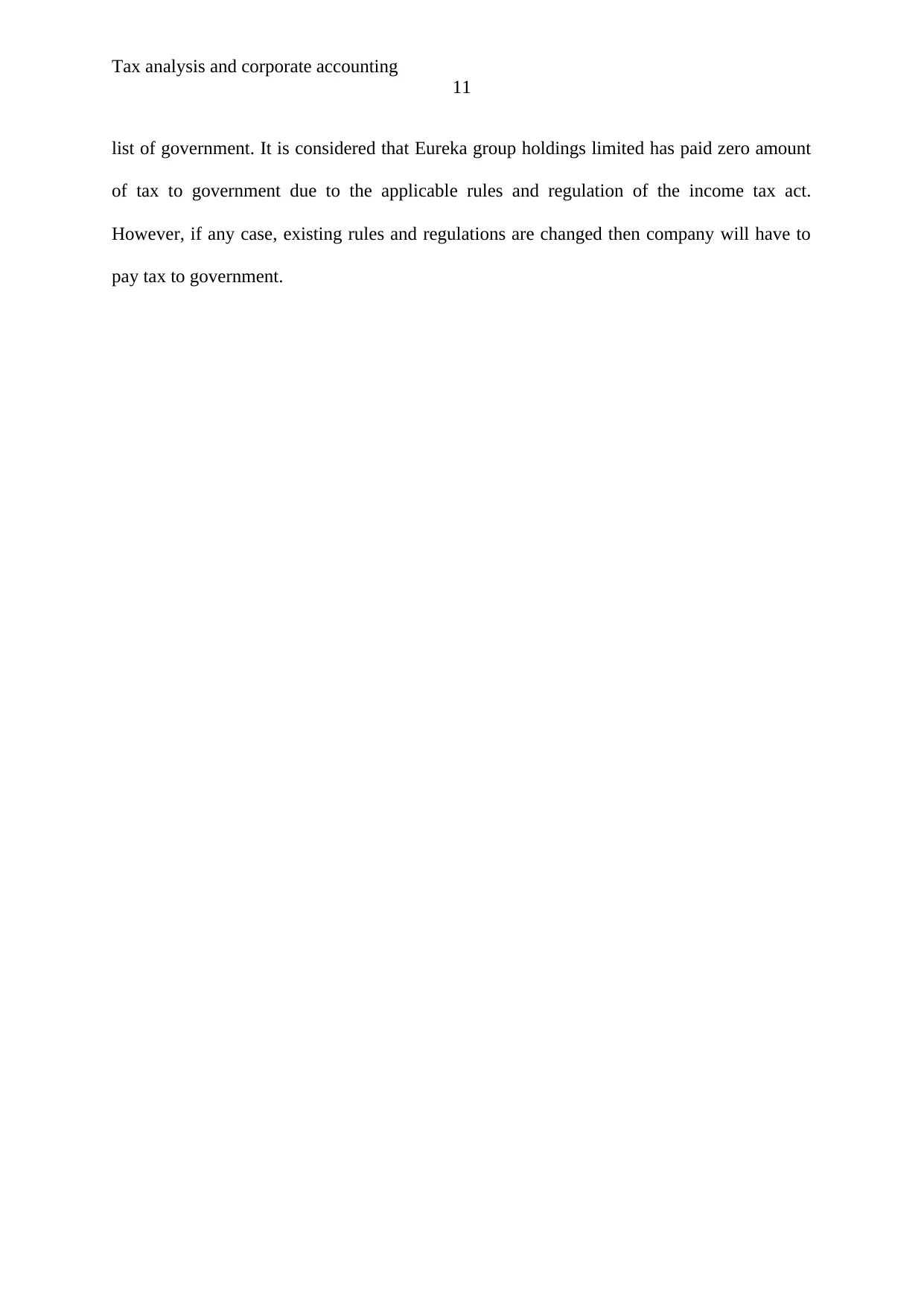
Tax analysis and corporate accounting
11
list of government. It is considered that Eureka group holdings limited has paid zero amount
of tax to government due to the applicable rules and regulation of the income tax act.
However, if any case, existing rules and regulations are changed then company will have to
pay tax to government.
11
list of government. It is considered that Eureka group holdings limited has paid zero amount
of tax to government due to the applicable rules and regulation of the income tax act.
However, if any case, existing rules and regulations are changed then company will have to
pay tax to government.
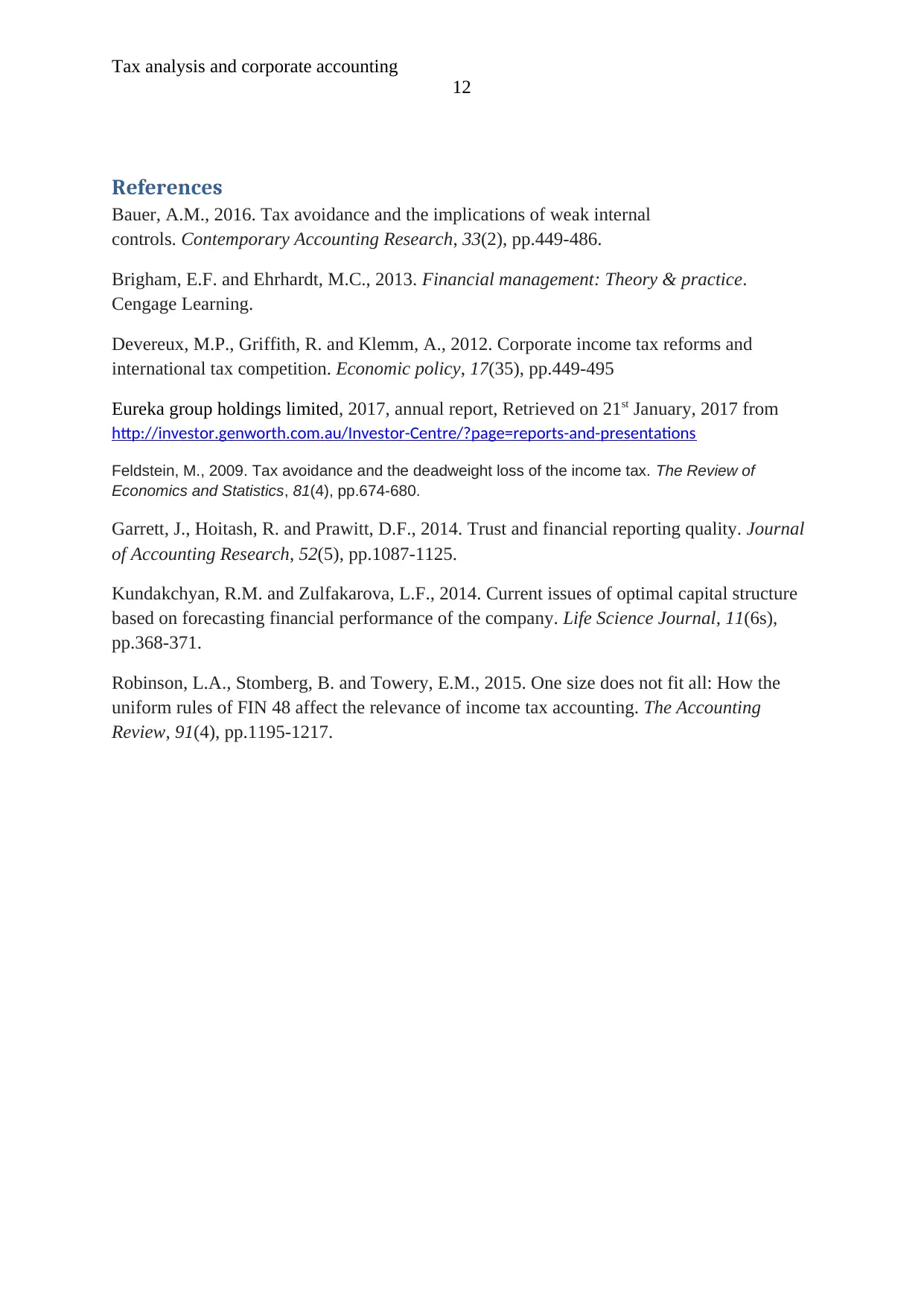
Tax analysis and corporate accounting
12
References
Bauer, A.M., 2016. Tax avoidance and the implications of weak internal
controls. Contemporary Accounting Research, 33(2), pp.449-486.
Brigham, E.F. and Ehrhardt, M.C., 2013. Financial management: Theory & practice.
Cengage Learning.
Devereux, M.P., Griffith, R. and Klemm, A., 2012. Corporate income tax reforms and
international tax competition. Economic policy, 17(35), pp.449-495
Eureka group holdings limited, 2017, annual report, Retrieved on 21st January, 2017 from
http://investor.genworth.com.au/Investor-Centre/?page=reports-and-presentations
Feldstein, M., 2009. Tax avoidance and the deadweight loss of the income tax. The Review of
Economics and Statistics, 81(4), pp.674-680.
Garrett, J., Hoitash, R. and Prawitt, D.F., 2014. Trust and financial reporting quality. Journal
of Accounting Research, 52(5), pp.1087-1125.
Kundakchyan, R.M. and Zulfakarova, L.F., 2014. Current issues of optimal capital structure
based on forecasting financial performance of the company. Life Science Journal, 11(6s),
pp.368-371.
Robinson, L.A., Stomberg, B. and Towery, E.M., 2015. One size does not fit all: How the
uniform rules of FIN 48 affect the relevance of income tax accounting. The Accounting
Review, 91(4), pp.1195-1217.
12
References
Bauer, A.M., 2016. Tax avoidance and the implications of weak internal
controls. Contemporary Accounting Research, 33(2), pp.449-486.
Brigham, E.F. and Ehrhardt, M.C., 2013. Financial management: Theory & practice.
Cengage Learning.
Devereux, M.P., Griffith, R. and Klemm, A., 2012. Corporate income tax reforms and
international tax competition. Economic policy, 17(35), pp.449-495
Eureka group holdings limited, 2017, annual report, Retrieved on 21st January, 2017 from
http://investor.genworth.com.au/Investor-Centre/?page=reports-and-presentations
Feldstein, M., 2009. Tax avoidance and the deadweight loss of the income tax. The Review of
Economics and Statistics, 81(4), pp.674-680.
Garrett, J., Hoitash, R. and Prawitt, D.F., 2014. Trust and financial reporting quality. Journal
of Accounting Research, 52(5), pp.1087-1125.
Kundakchyan, R.M. and Zulfakarova, L.F., 2014. Current issues of optimal capital structure
based on forecasting financial performance of the company. Life Science Journal, 11(6s),
pp.368-371.
Robinson, L.A., Stomberg, B. and Towery, E.M., 2015. One size does not fit all: How the
uniform rules of FIN 48 affect the relevance of income tax accounting. The Accounting
Review, 91(4), pp.1195-1217.
⊘ This is a preview!⊘
Do you want full access?
Subscribe today to unlock all pages.

Trusted by 1+ million students worldwide
1 out of 12
Related Documents
Your All-in-One AI-Powered Toolkit for Academic Success.
+13062052269
info@desklib.com
Available 24*7 on WhatsApp / Email
![[object Object]](/_next/static/media/star-bottom.7253800d.svg)
Unlock your academic potential
Copyright © 2020–2025 A2Z Services. All Rights Reserved. Developed and managed by ZUCOL.





